|


| |

Uruguay


 Uruguay, officially the
Oriental Republic of Uruguay is a country located in the southeastern
part of
South America. It
is home to some 3.5 million people of whom 1.4 million live in the
capital
Montevideo and
its
metropolitan area.
An estimated 88% of the population are of European descent. Uruguay, officially the
Oriental Republic of Uruguay is a country located in the southeastern
part of
South America. It
is home to some 3.5 million people of whom 1.4 million live in the
capital
Montevideo and
its
metropolitan area.
An estimated 88% of the population are of European descent.
Uruguay's only land border is with
Rio Grande do Sul,
Brazil, to the
north. To the west lies the
Uruguay River, to
the southwest lies the
estuary of
Río de la Plata,
with
Argentina only a
short commute across the banks of either of these bodies of water, while
to the southeast lies the southern part of the
Atlantic Ocean.
Uruguay, with an area of approximately 176 thousand km2, is
the second smallest nation of South America in area after
Suriname.
Colonia del Sacramento,
one of Uruguay's oldest European settlements, was founded by the
Portuguese in
1680. Montevideo was founded by the
Spanish in the
early 18th century as a military stronghold. Uruguay won its
independence in 1811–1828 following a three-way struggle among Spain,
Argentina and Brazil. It is a
constitutional democracy,
where the president fulfills the roles of both
head of state and
head of government.
Uruguay is one of the most
economically developed countries in South America, with a high
GDP per capita
and the 50th highest
quality of life
in the world. The economy is largely based on
agriculture
(making up 10% of
GDP and the most
substantial export) and the state sector. According to
Transparency International,
Uruguay is rated as the least corrupt country in
Latin America
(along with
Chile),
with its political and labour conditions being among the freest on the
continent
Montevideo Uruguay
The capital of Uruguay, the second-smallest country in South America,
Montevideo is located on the Rio de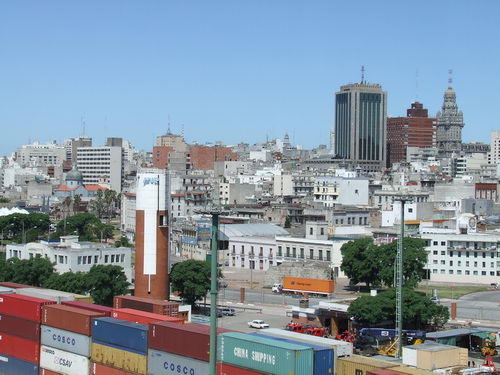 la Plata in the southern part of the
country. The city was founded in 1724 by the Spanish, and Uruguay was
established over a century later, in 1828, as a buffer state between
Argentina and Brazil. Modern- la Plata in the southern part of the
country. The city was founded in 1724 by the Spanish, and Uruguay was
established over a century later, in 1828, as a buffer state between
Argentina and Brazil. Modern-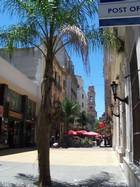 day Montevideo is known for its picturesque
architecture, impressive buildings, white sandy beaches and its fabulous
beach resorts
along the Atlantic Coast. Starting at Plaza Independencia, you can
explore the Ciudad Vieja, or Old City, with its colonial Spanish,
Italian and Art Deco structures and narrow, pedestrian-friendly streets. day Montevideo is known for its picturesque
architecture, impressive buildings, white sandy beaches and its fabulous
beach resorts
along the Atlantic Coast. Starting at Plaza Independencia, you can
explore the Ciudad Vieja, or Old City, with its colonial Spanish,
Italian and Art Deco structures and narrow, pedestrian-friendly streets.
The city's Museo Histórico Nacional is a
unique collection of four buildings located in Ciudad Vieja; all were
once homes to national heroes and have been preserved and filled with
art and artifacts.
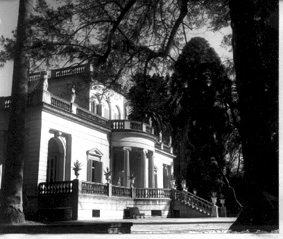 The Museo Municipal de Bellas Artes draws
all kinds of visitors
interested in the The Museo Municipal de Bellas Artes draws
all kinds of visitors
interested in the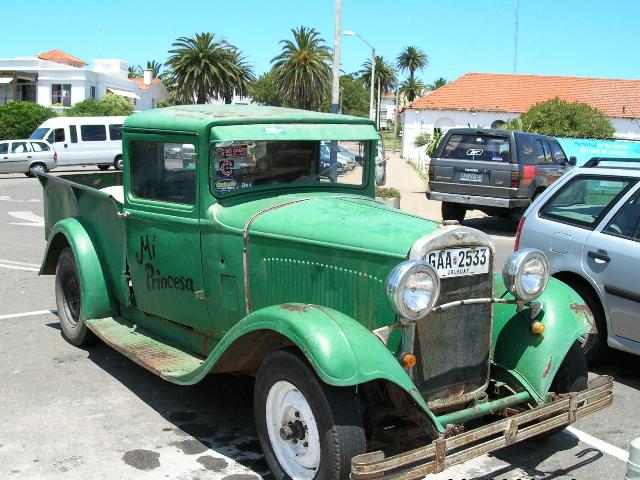 engaging artwork of famous South American artists. On
Saturdays, the Old City becomes a vast antique market offering fine
silver, jewelry and art. engaging artwork of famous South American artists. On
Saturdays, the Old City becomes a vast antique market offering fine
silver, jewelry and art.
This Old truck was outside the Art show...One
of the artists was driving it...
The Mercado del Puerto, the city's port market, is always a big draw as
it is packed with restaurants, clubs, bars and shops. It's a GREAT place for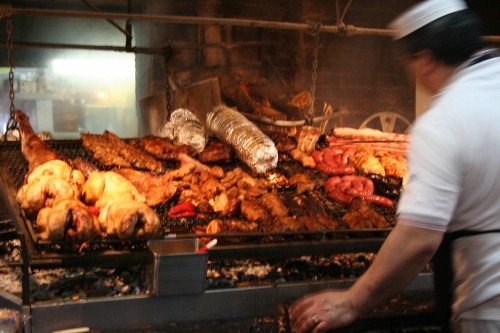 seafood as well as traditional parrillada, or beef platters.
We really enjoyed the festive
atmosphere, replete with street vendors and musicians. Happening discos
and nightspots keep the city alive well after dark. seafood as well as traditional parrillada, or beef platters.
We really enjoyed the festive
atmosphere, replete with street vendors and musicians. Happening discos
and nightspots keep the city alive well after dark.
 Tango clubs are
everywhere and are a popular diversion,
especially since famous tango scores were penned and performed for the
first time in this Montevideo. Tango clubs are
everywhere and are a popular diversion,
especially since famous tango scores were penned and performed for the
first time in this Montevideo.
Estadio
Centenario
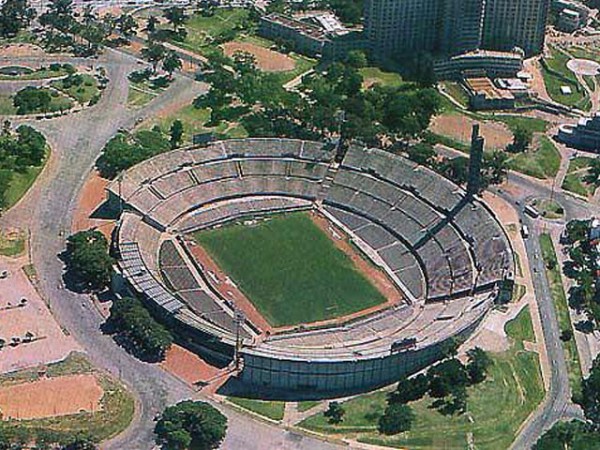
The stadium was built
between 1929 and 1930 to host the
1930 FIFA World Cup,
as well as to commemorate the centennial of
Uruguay's first constitution.
It is listed by
FIFA as
one of the football world's classic stadiums, along with the
likes of
Maracanã,
Wembley Stadium,
San Siro,
Estadio Azteca,
and
Santiago Bernabéu Stadium.
The
Uruguayan national team
has always been a threat when playing in their home stadium
(these folks are soccer NUTS),
consistently beating top teams. Even the top ranked
Brazil national soccer team
has only managed 3 wins in 20 opportunities, although only one
was an official match. Because of the Centenario's location next
to other smaller stadiums, when
Central Español
and
Miramar Misiones
play home matches simultaneously, one can watch all three games
from the top of the Amsterdam stand.
 Palacio Salvo Palacio Salvo
Palacio Salvo is a building located
at the intersection of
18 de Julio Avenue
and
Plaza Independencia,
designed by the architect
Mario Palanti,
an
Italian
immigrant living in
Buenos Aires,
who used a similar design for his
Palacio Barolo
in
Buenos Aires,
Argentina.
Finished in 1925, Palacio Salvo stands 100 metres high with the
antenna included.
It was built on the site where the
Confitería La Giralda was once located, a place renowned for
being where
Gerardo Matos Rodríguez
wrote his tango
La Cumparsita,
in 1917.
The building was originally intended
to function as a hotel, possibly mixed with some private
residential units. This did not work out, and it never
functioned as a hotel. There is now a mixture of offices and
private residences in the building.
Telecommunications Tower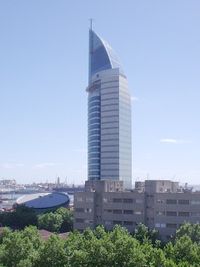
Torre de las
Telecomunicaciones (Telecommunications Tower) or Torre Antel (Antel
Tower) is a 158 meter, 37 floor
building,
headquarters
of Uruguay's
government-owned
telecommunications
company,
ANTEL,
and is the tallest building in the country. It was designed by
architect
Carlos Ott.
It is situated by the side of Montevideo's
bay.
The tower was completed by American Bridge and other
design/built consortium team members on March 15, 2000.
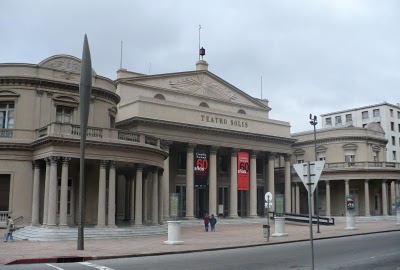 Solis Theatre Solis Theatre
Teatro Solís is
Uruguay's
oldest
theatre.
It was built in 1856 and is currently owned by the government of
Montevideo. It is located in
Plaza Independencia
(Ciudad
Vieja).
In 1998, the government of
Montevideo started a major reconstruction of the theatre, which
included two U$S110.000 columns designed by
Phillipe Starck.
The reconstruction was completed in 2004 with the re-opening
taking place in August of that year.
 Palacio Legislativo Palacio Legislativo
Current seat of the
Uruguayan Parliament,
the construction of this building started in 1904 sponsored by
the government of President
José Batlle y Ordóñez.
It was designed by
Italian architects
Vittorio Meano
and
Gaetano Moretti,
who planned the building's interior. Among the notable
contributors to the project was sculptor
José Belloni,
who created numerous
reliefs
and
allegorical sculptures
for the building.
 Montevideo Metropolitan Cathedral Montevideo Metropolitan Cathedral
This is the main
Roman Catholic
church of
Montevideo. It is located right in front of the
Cabildo
across
Constitution Square,
in
Ciudad Vieja.
The origin of the church dates from 1740, when a church
constructed of brick was built on the site. In 1790, the
foundation was laid for the construction of the current
neoclassical structure. The church was consecrated in 1804.
Cabildo de Montevideo
The Montevideo Cabildo is
the public building in Montevideo that was used as the
seat of government
during the
colonial
times of the
Viceroyalty of the Río de la Plata.
Today the building is used as a
museum.
It is located in front of
Constitution Square,
in
Ciudad Vieja.
Punta del Este, Uruguay

The St. Tropez of Uruguay
The
eastern spit of land separating the Atlantic
Ocean from the Rio del la Plata (see this
interactive
map
from Expedia) was once known to sailors and
fishermen as Cabo Santa María. Today, called
Punta del Este this area is known worldwide
as a scenic resort area with miles of
beautiful beaches, luxury hotels and
restaurants, glittery nightlife and an
upscale summer population.
For
decades Punta del Este was an exclusive
resort for wealthy South Americans, and it
is still expensive, but not as much as famed
European and US resort areas. The city and
resort appeal has attracted multiple
governments to hold summit meetings there.
A new
casino, more luxurious restaurants and
hotels, never ending sports activities,
plenty of natural attractions, shops,
nightclubs and a temperate climate beckon to
all travelers.
 An hour
and a half by car from
Montevideo,
Punta del Este offers twenty miles of
pristine beaches. You'll need a car to visit
them all or discover your favorite.
Mansa, or gentle beach, is on
the bay side, while the one facing the
Atlantic is Brava.
Photo.
These are terrifically crowded during the
summer season, which begins in December and
ends in March. An hour
and a half by car from
Montevideo,
Punta del Este offers twenty miles of
pristine beaches. You'll need a car to visit
them all or discover your favorite.
Mansa, or gentle beach, is on
the bay side, while the one facing the
Atlantic is Brava.
Photo.
These are terrifically crowded during the
summer season, which begins in December and
ends in March.
Locals use other beaches,
notably to La Barra del Maldonado, a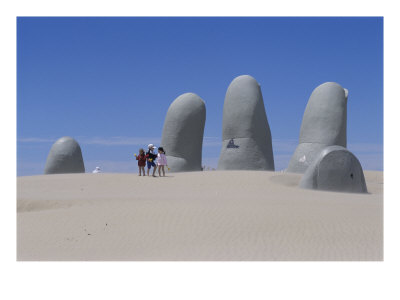 beautiful inlet that flows from the back bay
area of Maldonado out to the Atlantic Ocean.
One of the city landmarks are the Dedos,
fingers, in the sand at Playa Brava. See
photo
(right)
and you'll see why.
beautiful inlet that flows from the back bay
area of Maldonado out to the Atlantic Ocean.
One of the city landmarks are the Dedos,
fingers, in the sand at Playa Brava. See
photo
(right)
and you'll see why.
La
Barra is also the center of youth oriented
activities, from daytime
 sports on the fine
sandy beach to all night discos. To get to
this small village, you cross an unusual
bridge shaped like an easy roller coaster.
With all the water surrounding Punta del
Este, sailing is popular and large marinas
attract an international flotilla. sports on the fine
sandy beach to all night discos. To get to
this small village, you cross an unusual
bridge shaped like an easy roller coaster.
With all the water surrounding Punta del
Este, sailing is popular and large marinas
attract an international flotilla.
Punta
del Este is a relaxed life style. It is
geared to vacationers who get a late morning
start. Hotel dining rooms and services may
be open before noon, but the rest of the
city may not be. Dinner's are late, at 10 PM
or later, and discos go until dawn, allowing
partiers to see both the sun rise and set
over water. The Cipriani Lido at the
Cipriani Punta del Este Resort in La Barra
is one of the hottest spots in town.
Attractions
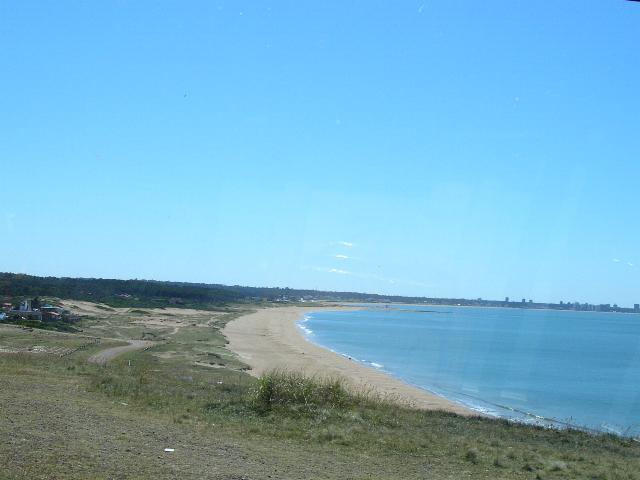 Beaches of course... Beaches of course...
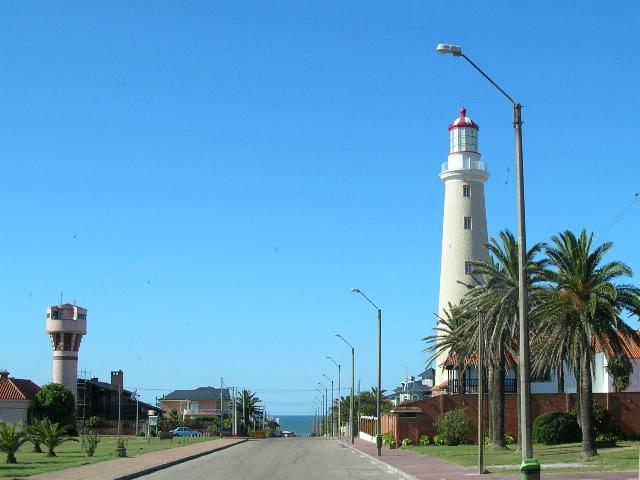 The
lighthouse dates from 1860, built by Tomás Libarena. The crystal prisms were
brought from France. The
lighthouse dates from 1860, built by Tomás Libarena. The crystal prisms were
brought from France.
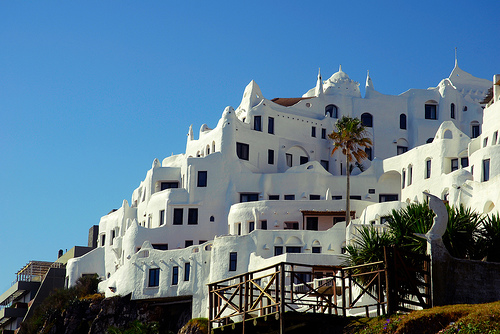
Casa
del Pueblo - Once the home of celebrated Uruguayan artist Carlos Paez Vilaro,
this eye-catching seaside Mediterranean-style structure is today a modern art
museum More photos at the bottom). We really like this place. More
photos at the end...
I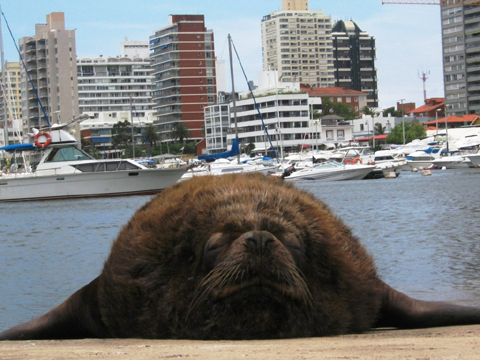 sla
de Lobos - 8 km from land, the island is by one of the world's largest sea-lion
colonies (ugly suckers). sla
de Lobos - 8 km from land, the island is by one of the world's largest sea-lion
colonies (ugly suckers).
There is a lighthouse on the island.
Parque Municipal
Zoológico Medina - It's a very large zoo with interactive exhibits.
Another zoo is:
Zoológico Pan de Azúcar -
Zoo with a large selection of native species set in natural settings.
T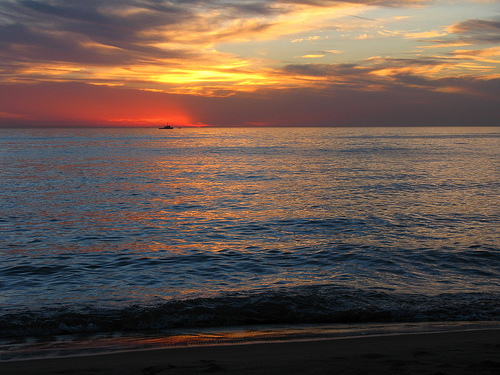 ake
a sunset or evening stroll along Gorlero, Punta del Este’s main place to see and
be seen. In the space of a few blocks, you’ll find restaurants, bars, shops,
cinemas, the Feria Artesanal. It is gorgeous... ake
a sunset or evening stroll along Gorlero, Punta del Este’s main place to see and
be seen. In the space of a few blocks, you’ll find restaurants, bars, shops,
cinemas, the Feria Artesanal. It is gorgeous...
 The nearby city of
Maldonado has several interesting attractions: The nearby city of
Maldonado has several interesting attractions:
From Plaza San Fernando,
visit the Diligencia de
 Castells Capurro
for some beautiful artwork. Castells Capurro
for some beautiful artwork.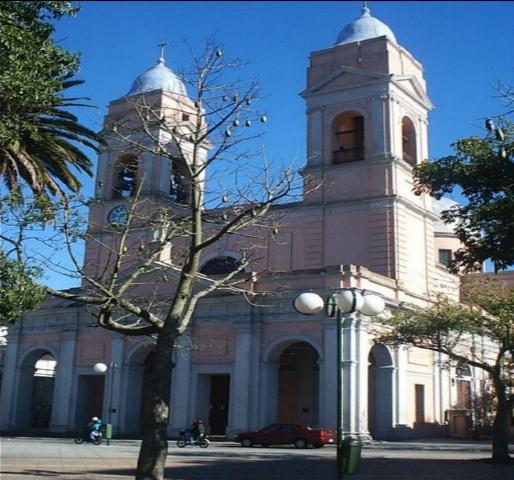
the neo-Classic Catedral
San Fernando, dating from 1895 and now an historic monument
Cuartel de Dragones
exhibition center,
military headquarters constructed between 1771 and 1797.
Marco de los Reyes in the
Plaza Torre del Vigía. This white and rose marble marker was created in Lisbon
in 1753 and erected to mark the division between Spanish and Portuguese holdings
in South America according to the 1750 Treaty of Madrid. marker was created in Lisbon
in 1753 and erected to mark the division between Spanish and Portuguese holdings
in South America according to the 1750 Treaty of Madrid.
Do you suppose the
residents of St. Tropez refer to it as the Punta del Este of France?
Buen viaje!
____________________________________________________________________________________________
Here are some more photos of the unique Casa
del Pueblo - Once the home of celebrated Uruguayan artist Carlos Paez Vilaro...
The Casa Pueblo is an art museum situated on a
outcropping of rock 5 minutes from Punta del Este. The museum represents the
work of one of the most famous Uruguayan painters whose name is Carlos Paez
Vilaro. He traveled the world, experiencing different cultures and learning
different techniques. He was fascinated by the island of Tahiti, which has a
great influence on his work. The architecture of the museum, also created by
Vilaro, is absolutely fabulous, built of adobe and rising out of the topography
of the rocks in wierd formations and curves.
The view from this site is
breathtaking.

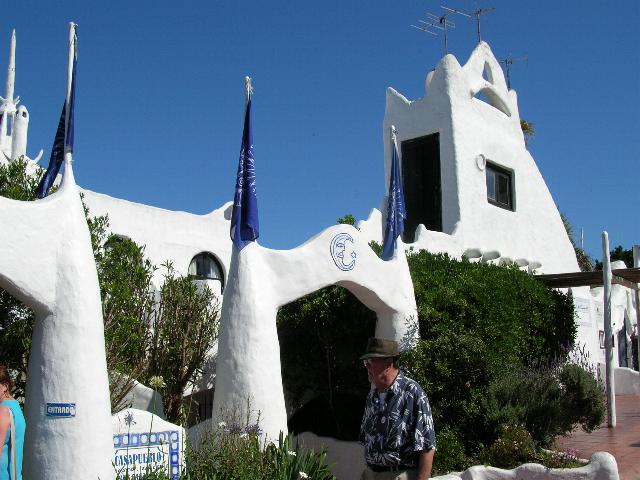

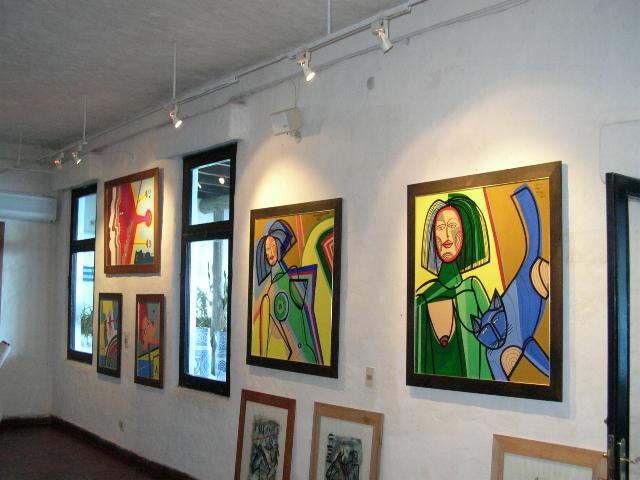
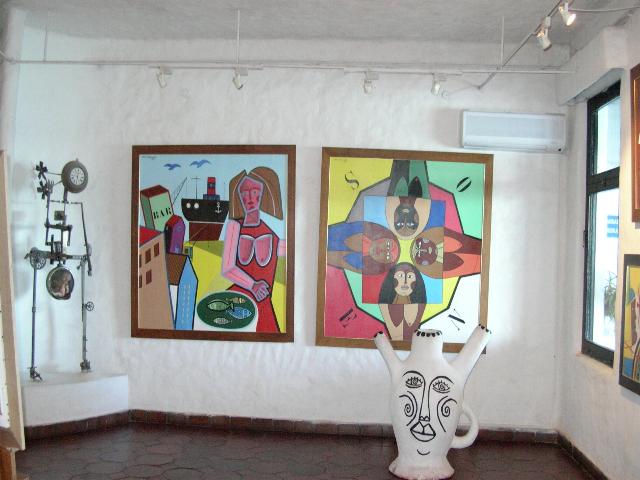
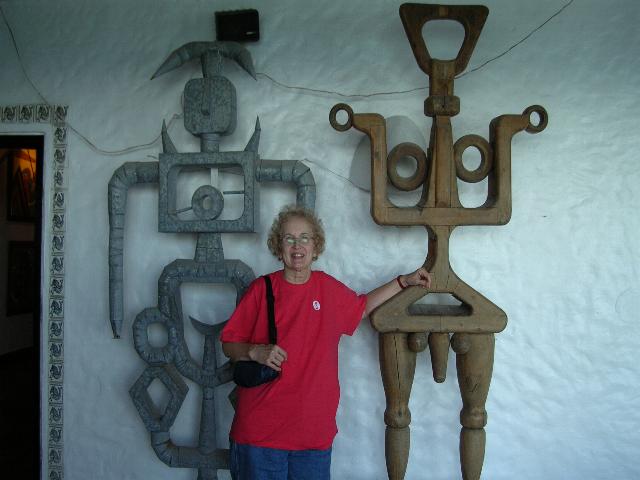
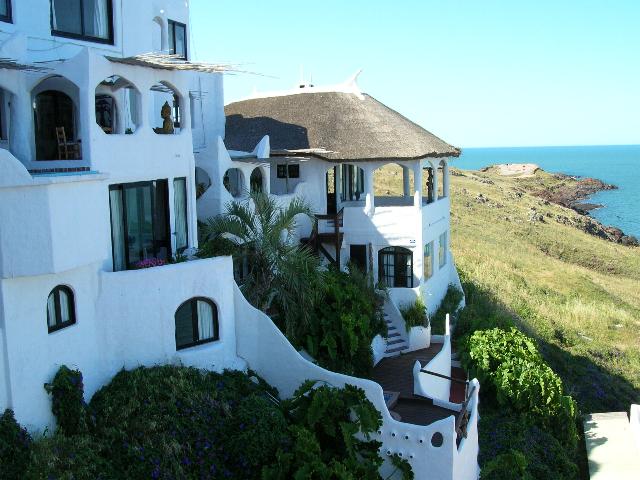
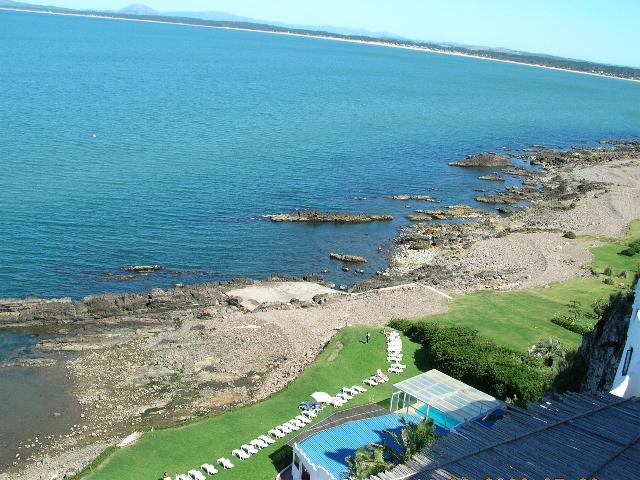
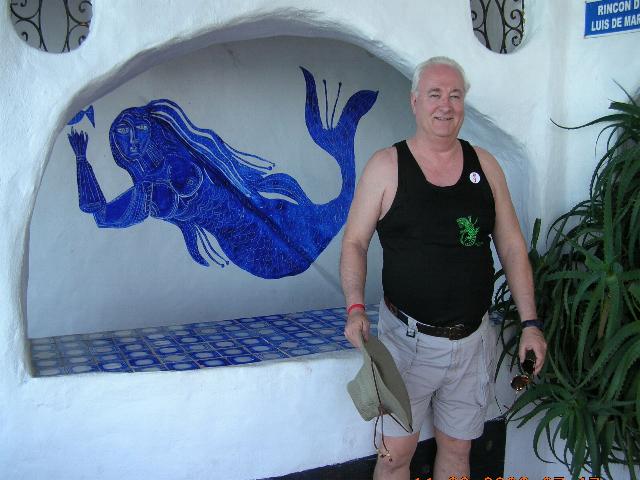
_______________________________________________________________________________________________________
Uruguay's brush with WWII....
German pocket battleship Admiral Graf
Spee
The
Admiral Graf Spee was one of the most famous
German naval warships of
World War II, along with
the
Bismarck. Her size
was limited to that of a
cruiser by the
Treaty of Versailles,
but she was much more heavily armed than a cruiser due to innovative
weight-saving techniques employed in her construction.
She was sent to the
Atlantic Ocean as a
commerce raider in 1939,
where she sank nine Allied
merchant ships, with a
total tonnage of 50,089.
Numerous British hunting groups were assigned to find her, with three British,
New Zealand and Australian cruisers finally tracking her down in December 1939.
The
Battle of the River Plate
ensued, during which the Graf Spee was damaged.
She docked for repairs in
the neutral port of
Montevideo, but was
forced by international law to leave within 72 hours. Faced with what he
believed to be overwhelming odds, the captain
scuttled
his ship rather than risk the lives of his crew.
Captain of the Gaf Spee
Captains Mess Dress
Lois with Gun off the Gaf Spee

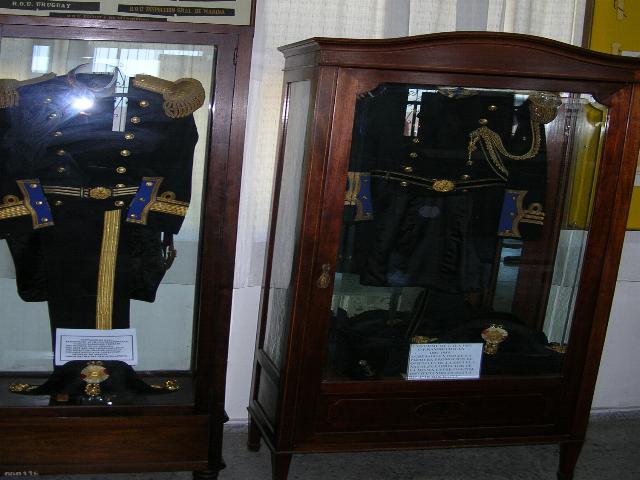
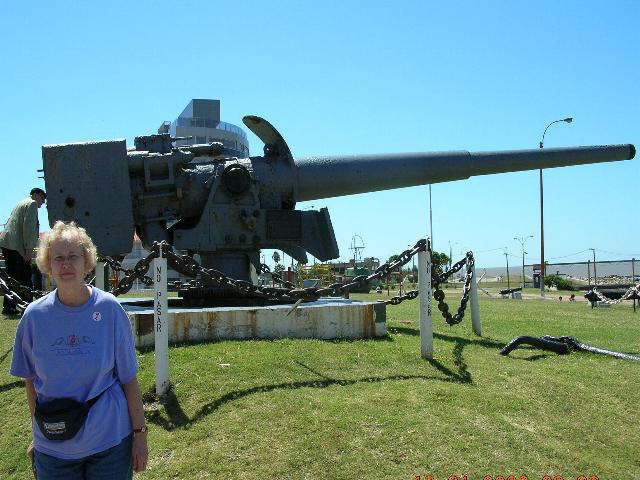
Graveyard Entrance Gaf Spee
Graveyard Markers Gaf Spee
Police escort assigned to us
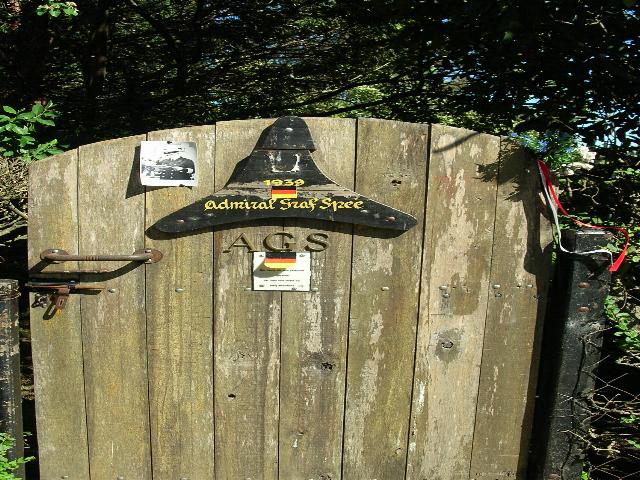
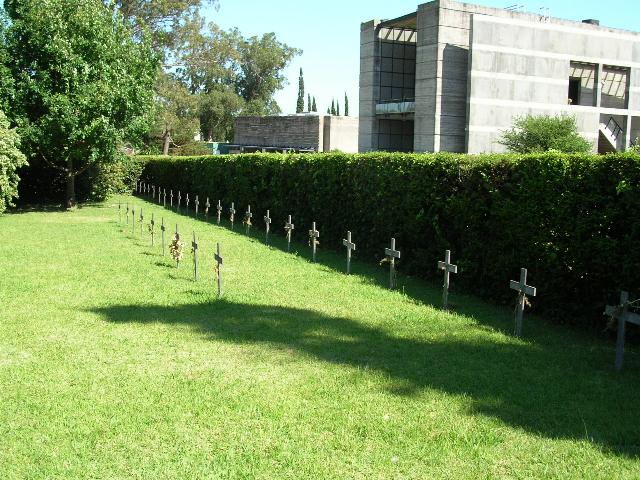


Admiral Graf Spee at the 1937
Fleet Review
at
Spithead.
In the background are the
battleship
HMS
Resolution and the
battlecruiser
HMS Hood. |
|
Career |
 |
| Name: |
Admiral Graf Spee |
| Namesake: |
Maximilian von Spee |
| Laid down: |
1 October 1932 |
| Launched: |
30 June 1934 |
| Commissioned: |
6 January 1936[1] |
| Nickname: |
Graf Spee |
| Fate: |
Scuttled 17 December 1939 |
|
General characteristics |
| Class and type: |
Deutschland class cruiser |
| Displacement: |
12,100 t standard;
16,200 t full load |
| Length: |
186 m (610 ft)[2] |
| Beam: |
21.65 m (71.0 ft)[2] |
| Draught: |
7.34 metres (24.1 ft)[2] |
| Propulsion: |
Eight 9-cylinder double-acting
two-stroke
MAN
diesels
two propellers, 52,050 hp |
| Speed: |
28.5 knots (53 km/h) |
| Range: |
8,900 nautical miles at 20 knots
(16,500 km at 37 km/h)
Or
19,000 nautical miles at 10 knots (35,000 km at 18.5 km/h) |
| Complement: |
1001-1,150[1] |
Electronic warfare
and decoys: |
Early version of
Seetakt radar[3] |
| Armament: |
6 × 280 mm (11 inch)
8 × 150 mm (5.9 inch)
6 × 105 mm (4.1 inch)
8 × 37 mm
10 × 20 mm
8 × 533 mm (21 inch) torpedo tubes |
| Armor: |
turret
face: (140 mm)
belt: (100 mm)
deck: 40-70 mm) |
| Aircraft carried: |
Two
Arado 196
seaplanes,
one catapult |
|





 Uruguay, officially the
Oriental Republic of Uruguay is a country located in the southeastern
part of
Uruguay, officially the
Oriental Republic of Uruguay is a country located in the southeastern
part of
 la Plata in the southern part of the
country. The city was founded in 1724 by the Spanish, and Uruguay was
established over a century later, in 1828, as a buffer state between
Argentina and Brazil. Modern-
la Plata in the southern part of the
country. The city was founded in 1724 by the Spanish, and Uruguay was
established over a century later, in 1828, as a buffer state between
Argentina and Brazil. Modern- day Montevideo is known for its picturesque
architecture, impressive buildings, white sandy beaches and its fabulous
day Montevideo is known for its picturesque
architecture, impressive buildings, white sandy beaches and its fabulous
 The Museo Municipal de Bellas Artes draws
all kinds of visitors
interested in the
The Museo Municipal de Bellas Artes draws
all kinds of visitors
interested in the engaging artwork of famous South American artists. On
Saturdays, the Old City becomes a vast antique market offering fine
silver, jewelry and art.
engaging artwork of famous South American artists. On
Saturdays, the Old City becomes a vast antique market offering fine
silver, jewelry and art.  seafood as well as traditional parrillada, or beef platters.
We really enjoyed the festive
atmosphere, replete with street vendors and musicians. Happening discos
and nightspots keep the city alive well after dark.
seafood as well as traditional parrillada, or beef platters.
We really enjoyed the festive
atmosphere, replete with street vendors and musicians. Happening discos
and nightspots keep the city alive well after dark. 

 Palacio Salvo
Palacio Salvo
 Solis Theatre
Solis Theatre Montevideo Metropolitan Cathedral
Montevideo Metropolitan Cathedral

 An hour
and a half by car from
An hour
and a half by car from
 beautiful inlet that flows from the back bay
area of Maldonado out to the Atlantic Ocean.
One of the city landmarks are the Dedos,
fingers, in the sand at Playa Brava. See
beautiful inlet that flows from the back bay
area of Maldonado out to the Atlantic Ocean.
One of the city landmarks are the Dedos,
fingers, in the sand at Playa Brava. See
 sports on the fine
sandy beach to all night discos. To get to
this small village, you cross an unusual
bridge shaped like an easy roller coaster.
With all the water surrounding Punta del
Este, sailing is popular and large marinas
attract an international flotilla.
sports on the fine
sandy beach to all night discos. To get to
this small village, you cross an unusual
bridge shaped like an easy roller coaster.
With all the water surrounding Punta del
Este, sailing is popular and large marinas
attract an international flotilla.  Beaches of course...
Beaches of course... The
lighthouse dates from 1860, built by Tomás Libarena. The crystal prisms were
brought from France.
The
lighthouse dates from 1860, built by Tomás Libarena. The crystal prisms were
brought from France. 
 sla
de Lobos - 8 km from land, the island is by one of the world's largest sea-lion
colonies (ugly suckers).
sla
de Lobos - 8 km from land, the island is by one of the world's largest sea-lion
colonies (ugly suckers).  ake
a sunset or evening stroll along Gorlero, Punta del Este’s main place to see and
be seen. In the space of a few blocks, you’ll find restaurants, bars, shops,
cinemas, the Feria Artesanal. It is gorgeous...
ake
a sunset or evening stroll along Gorlero, Punta del Este’s main place to see and
be seen. In the space of a few blocks, you’ll find restaurants, bars, shops,
cinemas, the Feria Artesanal. It is gorgeous... The nearby city of
Maldonado has several interesting attractions:
The nearby city of
Maldonado has several interesting attractions:  Castells Capurro
for some beautiful artwork.
Castells Capurro
for some beautiful artwork.
 marker was created in Lisbon
in 1753 and erected to mark the division between Spanish and Portuguese holdings
in South America according to the 1750 Treaty of Madrid.
marker was created in Lisbon
in 1753 and erected to mark the division between Spanish and Portuguese holdings
in South America according to the 1750 Treaty of Madrid. 

















